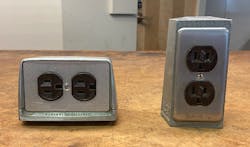Installation of Receptacles at Islands and Peninsular Countertops
Up through the 2017 edition of the National Electrical Code (NEC), there were requirements for “at least one receptacle outlet” for any island or peninsular counter larger than the prescribed minimum sizes [2017 NEC Sec. 210.52(C)(2) and (3)]. In the 2020 NEC, however, this was significantly expanded. Both island and peninsular counters are combined in Sec. 210.52(C)(2), and additional receptacles are now required based on the square footage of the countertop work surface.
When a counter is located adjacent to the wall, receptacles are required so that “. . . no point along the wall line is more than 24 in. measured horizontally from a receptacle outlet in that space ” [Sec. 210.52(C)(1)]. But other than a receptacle outlet required within 2 ft of the outer end of the peninsular work surface, the location of the additional receptacles along the horizontal work surface is not specified. Therefore, depending on how the island is constructed, many of us are now wondering, “Where do we put all these receptacles?”
Placement of receptacles at kitchen islands and peninsular counters is not a new question (see Photo 1). For many years, the receptacle location was at least partially left up to the Authority Having Jurisdiction (AHJ). Newer editions of the NEC have tried to answer this question with more clarity. The 2020 NEC is no exception to this progression.
In the 2017 Edition of the NEC, this issue of receptacle location is addressed in Sec. 210.52(C)(5):
“(5) Receptacle Outlet Location. Receptacle outlets shall be located on or above, but not more than 500 mm (20 in.) above, the countertop or work surface. Receptacle outlet assemblies listed for use in countertops or work surfaces shall be permitted to be installed in countertops or work surfaces. Receptacle outlets rendered not readily accessible by appliances fastened in place, appliance garages, sinks, or rangetops as covered in 210.52(C)(1), Exception, or appliances occupying dedicated space, shall not be considered as these required outlets.
“Exception to (5): To comply with the following conditions (1) and (2), receptacle outlets shall be permitted to be mounted not more than 300 mm (12 in.) below the countertop or work surface. Receptacles mounted below a countertop or work surface in accordance with this exception shall not be located where the countertop or work surface extends more than 150 mm (6 in.) beyond its support base.
“(1) Construction for the physically impaired
“(2) On island and peninsular countertops or work surface where the surface is flat across its entire surface (no backsplashes, dividers, etc.) and there are no means to mount a receptacle within 500 mm (20 in.) above the countertop or work surface, such as an overhead cabinet.”
In the 2020 NEC, the verbiage about receptacle locations is moved to Sec. 210.52(C)(3). It now says:
“(3) Receptacle Outlet Location. Receptacle outlets shall be located in one or more of the following:
“(1) On or above countertop or work surfaces: On or above, but not more than 500 mm (20 in.) above, the countertop or work surface.
“(2) In countertop or work surfaces: Receptacle outlet assemblies listed for use in countertops or work surfaces shall be permitted to be installed in countertops or work surfaces.
“(3) Below countertop or work surfaces: Not more than 300 mm (12 in.) below the countertop or work surface. Receptacles installed below a countertop or work surface shall not be located where the countertop or work surface extends more than 150 mm (6 in.) beyond its support base.”
With the preceding requirement for additional receptacles, the 2020 version of the NEC does allow the receptacles to be mounted in one or more of the allowed locations. Each of these options can have advantages and disadvantages.
Option 1
With the current drive toward open concept homes, it is not as common for an island or peninsular counter to have casework mounted to the ceiling above the countertop. Some islands and peninsular counters do have a backsplash, or workspaces, at differing heights. When this is the case, there are many options for installing receptacles in the backsplash or side of the higher workspace (see Photo 2).
Option 2
In the 2020 NEC, an Informational Note directs us to paragraph 406.5(G), which says receptacles cannot be mounted in a face-up position. Fortunately, products exist that address these needs. Traditionally, the basic pedestal outlet (sometimes referred to as a “tombstone” outlet) was the only solution that met these requirements (Photo 3). These are used in lab countertops but likely would not score any points with homeowners when it comes to aesthetics. Today, there are pop-up options for work surfaces (Photo 4). When pushed down, they are flush with the countertop and pop up when needed. The Code does distinguish between receptacles in countertops [NEC 406.5(E)] and those in work surfaces [NEC 406.5(F)]. In a work surface, such as a conference room table, it is assumed that a cup of coffee could be spilled so receptacles rated for this environment (UL 962A) must withstand 8 oz (1 cup) of liquid. However, in a kitchen countertop, much more liquid could be spilled, and the receptacle must withstand 64 oz (½ gallon). This is covered in UL 498, Section 146. Another thing to remember when using these receptacles is that they extend down below the workspace and may interfere with the casework and space below. (Note that the device below shows what extends below the counter).
Option 3
For safety reasons, receptacles at or above the surface are the preferred solutions. Imagine toddlers grabbing a cord to an appliance that is in use on the counter above and pulling it down onto themselves with disastrous consequences. When there is an overhang of 12 in. or more, most likely people will be sitting around the counter on chairs or bar stools. A cord dangling over the counter to reach a receptacle could potentially be caught by someone’s knee with similar problematic results. Consequently, the specific height and location requirements need to be followed (Photo 5).
Practical application
The countertop in Photo 6 of this island is 4 ft × 7 ft 4 in. for a total area of 29.3 ft2. According to Sec. 210.52(C)(2)(a), a receptacle is required for the first 9 ft2 and another receptacle for every additional 18 ft2 or fraction thereof of countertop or work surface. The resultant requirement for this island would be three receptacles.
Although the island in Photo 6 was built prior to adoption of the 2020 NEC, the clever cabinet maker allowed for all three receptacles. Arrow 1 in the photo points to a trap door that (when opened) reveals a GFI receptacle. There is a similar trap door/receptacle arrangement on the opposite side of the island.
Then, for the third receptacle, there may also be situations that require some commonsense application of the Code at the discretion of the AHJ. In this photo, Arrow 2 points to a receptacle that was installed under the countertop overhang but close to the edge where draping of the cord could be minimized. Although not in exact compliance with the letter of the Code [Sec. 210.52(C)(3)(3)], the reasoning noted in Sec. 210.8 could be employed: “...the distance shall be measured as the shortest path the cord of an appliance connected to the receptacle would follow....”
Conclusion
The requirement for additional receptacles in islands and peninsular countertops makes these workspaces more usable, convenient, and above all, safer. The options allowed for these situations in the 2020 NEC, coupled with forethought and early collaboration with the owner/architect, permit the appropriate installation of receptacles without compromising safety.
Garth Stevens, P.E., is a senior electrical engineer with Morrison-Maierle. He can be reached at [email protected].
About the Author
Garth Stevens, P.E.
Electrical Engineer
Stevens, P.E., is an electrical engineer with Morrison-Maierle, headquartered in Helena, Mont. He can be reached at [email protected].






